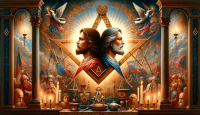The Mystery of St. John in Freemasonry: A Symbolic Journey of Balance and Enlightenment
08 February 24
Have you ever wondered why St. John is so significant in Freemasonry? Freemasonry, a fraternity shrouded in symbols and ceremonies, holds the “Holy Saints John” in high regard, particularly within the Entered Apprentice degree. This article delves into this intriguing aspect, exploring its historical and symbolic significance.
The origins of this veneration are as mystical as Freemasonry itself. The association with Saint John the Baptist and Saint John the Evangelist dates back centuries yet remains wrapped in mystery. Medieval guilds often dedicated themselves to a patron saint for protection and favor, a tradition possibly influencing Freemasonry. However, unlike these guilds, Freemasonry is not a religious organization. Despite its birth in a predominantly Christian Europe, Freemasonry embraces members of all faiths, making its connection to the Christian Saint Johns intriguing.
The significance of these two patron saints lies in their balanced duality. John the Baptist represents passionate zeal, while John the Evangelist symbolizes the knowledge of faith. Together, they offer a balanced path toward enlightenment, embodying Freemasonry's pursuit of wisdom and passion. The feast days of these saints, aligning with the summer and winter solstice, further underscore their symbolic duality in the Masonic context.
The deeper connection: The Gospel of St. John and the Mason Word. In the 17th and 18th centuries, new Masons took their obligations on the Bible, specifically opened to the Gospel of St. John. This practice linked the Masonic ritual to the Gospel's opening verse, intertwining the "Mason Word" - a secret granting access to Freemasonry’s privileges - with the "Word" in the Gospel. Such was the significance of this connection that Masons were sometimes referred to as “St. John’s Masons.”
But what's the conflict here? The exact reason why Freemasonry adopted the two Saint Johns as its patron saints remains unverified. While some historical clues suggest a connection to the Gospel of St. John, the full story is lost in time. This ambiguity creates a connection between the known and the unknown in Masonic tradition.
Adapting to this uncertainty, Freemasons embrace the symbolism. While the historical connection may be cloudy, the symbolic relevance of the Holy Saints John is clear. Their representation in Masonry serves as a metaphor for the journey of a Mason – balancing passion with knowledge, action with reflection.
However, this reverence has faced challenges. The decline in traditional religious practices and the evolution of Freemasonry in a multi-faith world pose questions about the relevance of these Christian saints in a modern, diverse fraternity.
What can be learned from this? The story of the Holy Saints John in Freemasonry teaches the importance of understanding and adapting historical traditions to contemporary contexts. It's a lesson in balancing respect for tradition with the evolving nature of societal beliefs.
In conclusion, the role of St. John in Freemasonry transcends historical facts. It represents a deeper symbolic journey towards balance and enlightenment, embodying the Masonic quest for moral and spiritual growth. Grasping this concept allows one to value the intricate web of meanings and metaphors that characterise Freemasonry, underscoring its continuous quest for knowledge and personal growth.
This is the essence of the Masonic reverence for St. John: a bridge between the past and the future, guiding Masons in their quest for enlightenment.
Inspired by: Why is ST. John the Patron Saint of Freemasonry? By John L. Cooper, PGM


